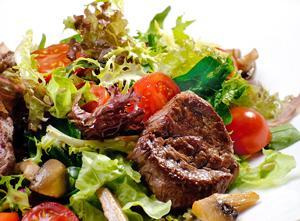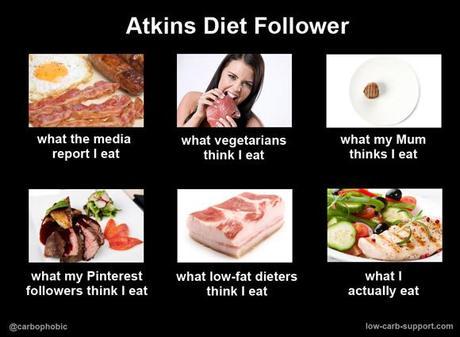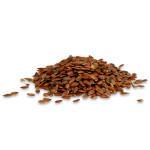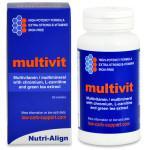 Having recently posted an overview of five popular low-carb plans, I’ve been asked which is the one I prefer myself. So I have to say, for me personally, it is still the good old Atkins.
Having recently posted an overview of five popular low-carb plans, I’ve been asked which is the one I prefer myself. So I have to say, for me personally, it is still the good old Atkins.
Having lost a substantial amount of weight on Atkins back in 2007, I still follow Atkins Maintenance principles, with some additions.
Below is my subjective view and advice about what’s it like to go on Atkins. I also included some FAQs and links to Atkins-related resources.
Atkins Diet – quick overview
Atkins consists of four phases, starting with a really strict two-week Induction phase, and gradually relaxing over the next three phases. If you can manage the first two weeks, the rest of the diet will be much easier. By definition, the diet is low in carbs, and high in fat and protein.
Your carb allowance starts with a very small amount on Induction, and increases in increments throughout the next two phases. The last stage of Atkins – Maintenance – is really a set of nutritional guidelines rather than a diet, with all wholefoods back on the list (only sugar and white flour are excluded).
By this stage, your carbs intake could be up to around 100g a day or over, but mostly likely still lower than that of people who eat sugar and grains (which is most people – unless they are also on low-carb).
Atkins Induction
Atkins Induction is designed to reset your food habits and kick-start fat-burning. Induction is highly prescriptive, with a set of specific rules, permitted foods list and carb limit of just 20g net carbs a day. This carb allowance amounts to several cups of salad vegetables a day. Read my earlier post for more information on Atkins Induction vegetables and best cooking methods.
Although Induction is quite radical, you only have to do it for two weeks. if you wish, you could do it for longer, up to six months and even a year.
Atkins Induction is very similar to Keto diet, which is used extensively to treat some medical conditions. Contrary to the stereotypes perpetuated by the media, there is no evidence that this diet is bad for your health, with many people reporting just the opposite.
Atkins Induction and Ketosis
If you have never tried low-carb before, Induction will be quite a shock to the system. After the first 2-3 days of carb withdrawal, you might start feeling very tired, headachy and desperate for carbs – the infamous “Induction flu”. It has to get worse before it can get better! Here’s some advice on coping with sugar cravings.
The next 3-5 days are hardest part of the diet, and many people will give up at this point. If you stick with it, it will be worth it – eventually you smash through the carb addiction wall and get into ketosis.
Ketosis is a natural state which occurs when you body starts burning fat for energy. It feels wonderful – Induction flu disappears, hunger and sugar cravings go away completely, and your energy levels surge to the levels way above pre-Atkins.
It is very easy to lose weight when in ketosis, as you burn through the fat without feeling hungry at all. However, you must keep your carb intake levels very low to stay in ketosis, otherwise you get knocked back to (almost) square one.
Boredom might be the only serious problem for some people. You can have nice interesting food on Induction, but you will need to make some effort to get suitable recipes and start cooking meals from scratch. Have a look at these low-carb cookbooks, low-carb recipes on this website, and this post about Atkins Induction desserts.
Atkins Induction and exercise
Dr Atkins strongly recommends doing exercise alongside the diet. However, I think it is important to stay in your comfort zone and not to push yourself too hard initially, until you get into ketosis.
If you already have an exercise routine, just stick with it as is. If you don’t do any exercise at the moment, do something gentle like going for 20-30 minute walk every day. Once you get into ketosis, you can think about increasing your exercise levels (you will have extra energy to burn!)
Atkins Induction supplements
Dr Atkins strongly encouraged supplementation in his original book – have a look at this post for the full list of recommended Atkins Diet supplements. In his opinion, correct supplements can help to optimise the diet and speed up transition to ketosis.
Have a look in our online shop for low-carb diet vitamins and supplements (delivery to UK, EU and USA).
Atkins Ongoing Weight Loss (OWL) phase
After Induction, you progress to Ongoing Weight Loss (OWL), where you increase your carb allowance by 5g, to 25g a day, and stay at that level for another week. The week after that, add another 5g net carbs to your daily allowance and so on. Other types of foods such as nuts, fruit and pulses are gradually added back to the diet.
You should keep monitoring your weight loss. Once it stops, this means you found your individual carb allowance. In order to lose weight, you need to keep your carbs intake under that level.
Atkins Maintenance phase
Once you have achieved the desired amount of weight loss, you should move into Pre-Maintenance and finally, Maintenance stage, and aim to stay there forever. Yes, that’s right, forever!
Before you run for the hills, please note that Maintenance stage includes pretty much all wholefoods. The only foods that are excluded forever and ever are white sugar and white flour. All dietitians agree that cutting out these two products is beneficial, for many reasons beyond weight loss.
This is actually a very important point to bear in mind, whether doing Atkins or another diet. If you want your weight loss to be permanent, you need to make permanent changes to your lifestyle and nutrition. If you think of a diet as a quick-fix, you will put the weight back on once you revert back to your old habits.
Atkins Nutritionals products
Atkins Nutritionals was founded by Dr Atkins, but since his death has been sold over several times to different corporate owners. Their commitment to the original philosophy of the diet has become somewhat compromised by their drive to make profits. Atkins Nutritional brand is now used on a range of low-carb products such as chocolate bars, sweets, shakes etc, including things like breakfast cereal and bread mix.
Unfortunately, many of these products are laden with an array of chemicals, and not all of them comply with the permitted foods lists. Unless you are completely desperate, it’s best to stay away from these products, at least when you are on Induction. If you decide to try them after Induction, do think of them as a treat and definitely not something to have every day.
You would be better off making your own low-carb desserts from scratch – at least then you know exactly what’s inside and how many carbs.
Are you ready to go?
If this basic overview sounds like you want to give it a go, I strongly recommend doing more research to ensure you fully understand all the rules of the diet and how it works.
Ideally, you should read one of the two official books:
Dr Atkins New Diet Revolution
Updated edition (2003) of the original book, written by the man himself
Buy this book on Amazon UK | Buy this book on Amazon US
New Atkins for New You
Revised version of the diet (2010), written by Eric C Westman; Stephen D Phinney; Jeff S Volek
Buy this book on Amazon UK | But this book on Amazon US
if you don’t want to buy the book, the basic guidelines to the diet are also on their official websites:
Atkins Diet Official Website
UK site | US site | Other regions
If you are on Google+, please have a look at our G+ Community for Atkins Diet followers.

Products you might be interested in – Atkins Diet Supplements:

Flax/Linseed 250g
£2.50 £2.50Around: $4.18 | €3.02
Paying in USD or EUR


Triple Omega Oils
£3.50 £3.50Around: $5.86 | €4.23
Paying in USD or EUR


Psyllium Husks 200g
£4.15 £4.15Around: $6.95 | €5.01
Paying in USD or EUR


Co-enzyme Q10
£6.79 £6.79Around: $11.36 | €8.20
Paying in USD or EUR
Sugar-free, gluten-free, zero carb
Co-enzyme Q10 30mg, includes 5mg of vitamin E (40% of RDA)
Recommended by Dr Atkins to supplement Atkins Diet
Essential for the production of energy on a cellular level
Contributes to the protection of cells from oxidative stress
Oil-based for better absorption
30 capsules
" data-product-id="2245" data-lang="en" data-name="Co-enzyme Q10" class="yotpo bottomLine" data-appkey="FMJ95LaEr6uumEaGlKnG4gaHUwO8FwTdRK1k5N8h" data-domain="low-carb-support.com" data-image-url="http://low-carb-support.com/wp-content/uploads/2013/07/co-enzyme-q101.jpg" data-product-models="0700461020530" data-bread-crumbs="">

Low-Carb Diet Multivitamins
£22.00 £15.40Around: $25.77 | €18.60
Paying in USD or EUR
Are you on a low-carb diet?
This targeted formula will help you.
- � Prevent nutritional deficiencies, because you eat less of fruit and grains on a low-carb diet
- � Reduce tiredness and fatigue, common at first stages of low-carb diets
- � Boost energy-yielding metabolism
- � Curb sugar cravings by normalising blood glucose levels
Delivering to UK, European Union and USA
" data-product-id="2248" data-lang="en" data-name="Low-Carb Diet Multivitamins" class="yotpo bottomLine" data-appkey="FMJ95LaEr6uumEaGlKnG4gaHUwO8FwTdRK1k5N8h" data-domain="low-carb-support.com" data-image-url="http://low-carb-support.com/wp-content/uploads/2013/07/multivit1.jpg" data-product-models="0609613810220" data-bread-crumbs="">

Posted on 3 January 2014 by Carbophobic. Atkins, Diet tips and aids

